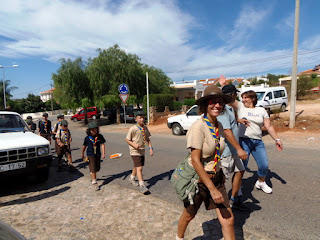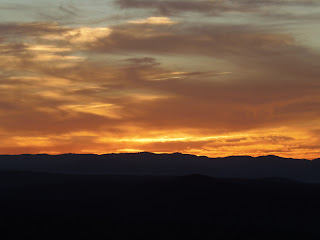Let the pictures speak.
On Sundays the Espargal expats gather at the Coral for brunch. Our numbers range from four to fourteen. Here we are in strength. Celso and Brigitte sweat to keep the coffees and croque-madames flowing.
Nor are we the only clients. Sunday cyclists use the Coral as a watering point, clattering into the snackbar on their toes-up cycling shoes. Time to admire muscular bronzed legs, smart bikes and striking outfits. Cycling is a popular sport in Portugal. For myself, I haven't been on a bike since we left London.
A ramble of scouts, male and female, comes trekking past, whence and to where it's hard to know. As I reflect to my companions, gone are the girl guides. These days, all are scouts - and the better for it to judge by the company and the smiles. My old scoutmaster dad wouldn't have known what to make of it.
Next a rally of cyclists comes whizzing past, scores of them, with an ambulance in tow for any casualties. Are they rallying against the latest austerity measures, like other demonstrators today across the length of Iberia, we wonder. But signs of protest there are none. This lot is out for morning's fun.
A long line of 4x4s makes its way to a nearby arena for the final day of a 4x4 weekend. We've seen the tents and lights and heard the music. They are clearly having a great time. Benafim hasn't seen experienced such a whirl of activity in years - summer's final fling.
For rain is on the horizon. We hope in vain that a few of the promised showers will fall on us. But they are few and far between. Jones's long-range picture shows as close as they come - not close enough! Rain is forecast for next week. Lord knows, we need it.
Down to Quinta do Lago for a walk along the causeway that runs from the resort through the nature reserve to the far end of the runway at Faro airport. It's a popular route for walkers and cyclists, as well as bird-watchers who take up position in the hides overlooking the tidal ponds.
The walk takes us between the golf course and the tidal mud flats. When the tide is in, walkers have to borrow the edge of the raised fairway to get past. When it's out, they behold the thousands of little crabs that stare crookedly back in return, scuttling to the safety of their holes when people pass too close for comfort.
Rolf's picture gives one a better idea of the location. This is one of Europe's premier resorts. There's no finer place for a coastal walk or a game of golf. I stop to assist a golfer to find his missing ball. I must have recovered a dozen down the years. Most of them were probably his, the golfer tells me.
Rolf himself walks with a curious and tireless lope. He is exceptionally long-legged and strides along like one of those mechanical monsters in Avatar. Although he gives the appearance of going slowly, his companions find themselves hurrying to stay up.
It takes the best part of an hour to reach the far end of the causeway. On either side are marshy ponds brimming with bird-life, and in the distance white mountains of salt, waiting to be loaded and bagged. Much of it is used in swimming pools and water softeners.
We try to photograph the planes taking off from Faro airport. But the sun is blinding and there's nothing to be seen in the camera screen other than one's own squinting face. I had to crop this picture a bit. Even so, it isn't a bad effort. Yes, that's Cathy again.
And here's Jones's arty picture, the ribby skeleton of a once proud boat, A noble vehicle for conveying fishermen to sea is reduced to an artwork at the mercy of the elements it braved. There's a story to be told. (That's enough poetic sentiments!) At the end of the walk lies Faro
beach and the Eléctrico, a favourite stop. The word means "tram"; until it burned down, the snack-bar was housed in an old tram. Its sandwiches (ham and cheese), whether fresh or toasted, are unbeatable. Across the estuary, planes rush down the runway to launch themselves skywards.
Beside us a large table is set for more serious diners, who have obviously arranged in advance for such a meal to be served. We speculate about why just a single woman is present among the group of men. They sound like sophisticated Lisbonites, down on holiday.
Around the corner the proprietor grills their fish on the fire in traditional fashion. It's said to taste best off the coals and at many restaurants, a member of staff can still be seen in the courtyard, doing the grills in time-honoured manner.
When it comes to grilling fish, Rolf is a dab hand himself. He visits the fish market in Loule to select tuna steaks that he's happy to prepare over the stove or fire, lightly grilled on both sides. They melt in the mouth, served on bread with his excellent salads.
A neighbour, Ana, comes round with husband, Vitor, and family to collect almonds from the trees. We have far more than can use. Almonds are an important ingredient of the spectacular cakes that Ana makes. She bakes, ices and sells them to order in all shapes, colours and sizes.
One evening we watched the sunset from the beacon 200 metres above us on the summit of Espargal hill. From here on a clear day one can see nearly forever - from Monchique in the west to beyond Faro in the east. Peace descends on our bit of the world. For such blessings, we offer libations to the gods.
As I'm late, having stayed behind to feed the dogs, I arrive at the beacon by tractor. With darkness falling, we descend the steep track, Jones nervously clutching the safety rail. We encourage the wild vegetation that covers the track as it in turn discourages motorcyclists who like to hurtle around the countryside.
This is a Jones sunrise. Dawn is her time of day. It's a time I prefer to spend in bed as I generally wake fourish for a while before falling heavily asleep again. Coffee and toast arrive at 7.30, along with the dogs waiting to be walked. Wet muzzles come poking under the blanket.
Here's my wife at her morning desk. She has been making unsteady progress on the iPad, appreciating its usefulness while resenting the intrusion of such technology into her life. She's an old-fashioned lady, who prefers the feel of pen on paper. Even so, her touch typing on the iPad keyboard is
fast and precise.
Jones has been practising her close-ups on the new camera, trying to remember how to get to the appropriate settings. We discover that the camera has been programmed with animal face-recognition technology. (Yes, I know, this is a flower!)
Dubiously, we set it to photograph automatically any dog or cat face that comes into view. It works! Ono and Prickles find themselves being photographed each time they look at it. Extraordinary! I am reminded of the eye-recognition cameras in the film, Minority Report.
Prickles, an inveterate traveller, takes umbrage at the barking we get each time we pass the dogs at the bottom of the village. And he leaps up to express his outrage at the canine insults clearly being hurled at us. Prickles is not a dog to take things lying down.
As he explains, such impudent behaviour is really more than a dog can bear. When it comes to being cute, there are none cuter than Prickles. But he's equally adept at raising the middle claw and heading off into the wilderness. "Pricks' rules!" is his motto.
We retire to the upper patio for sundowners. Rolf and I appreciate a good whisky, served in a worthy glass. Cathy generally settles for a beer shandy "just one please or it goes to my head". Jones, need I say it, is a baggy lady - with a generous squeeze of lemon. It's the only way to finish the day.
Peering down on us is the crescent moon, rather harder to photograph than my excellent picture suggests. Enough has been written about the moon not to require any more from me. And anyhow, as I said, this week's blog is meant to be about the pictures.




























No comments:
Post a Comment